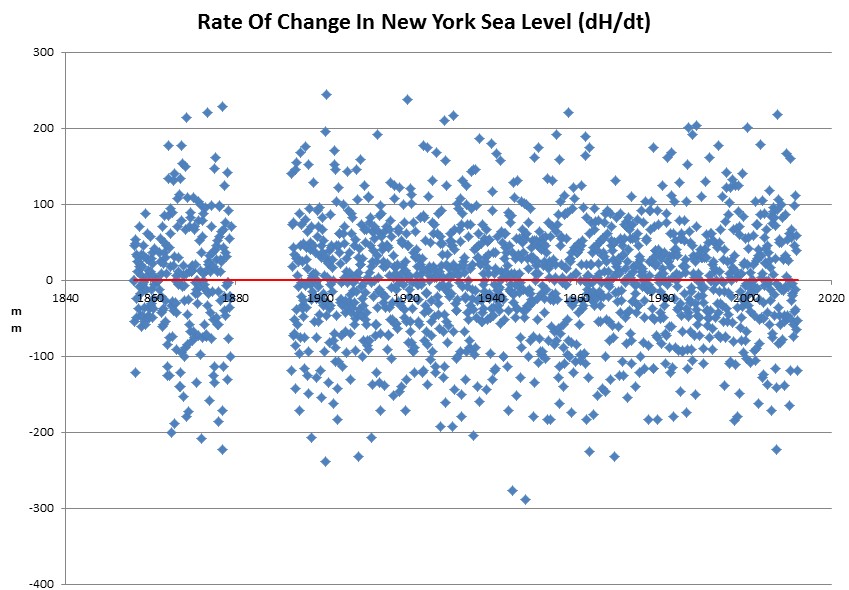The New York Times sees themselves defenders of big science.
Last month’s “weather event” should have taught us that. Whether in 50 or 100 or 200 years, there’s a good chance that New York City will sink beneath the sea.
The tide gauge at Manhattan shows 4 mm/year change in sea level over the last 150 years, and no change in the rate of sea level rise during that period. This means we can expect about 35 cm (14 inches) of additional “sea level rise” by the year 2100 – almost all of which is due to post glacial rebound causing the land to subside.
I’m guessing that the Statue Of Liberty is more than fourteen inches tall.







These people read too many comic books and pulp science fiction novels. That, plus a brain pickled by acid can cause all kinds of weird delusions.
Well hey, you have to remember, those comic books are set in alternate realities, where the physics work a bit differently…….
alternate realities, where the physics work a bit differently…….
http://youtu.be/rP9Qp5QWRMQ
remember this is New York physics work different in New York.
“Big Seance at the New York Times”? Or “Prig Science at the New York Times?
Either way, waders required, and not due to high water.
MUCK Boots! On sale now at your local farm supply store! 😉
Good Science
Dr Richard Milne – Critical Thinking on Climate Change
http://youtu.be/gh9kDCuPuU8
He talks about good science to support something that is not based on real world evidence. AGW was created by an opinion poll and is based in politics, not science.
The promoters of AGW are the true deniers.
He says right off the bat that, “Now if THE SCIENTISTS are anywhere near correct, then this is the greatest challenge facing humanity today…”
So I have to assume that he believes that all scientists agree. That makes him a nutcase.
More like “Political Stinking”.
.
Critical Thinking? He proves himself wrong on critical thinking when talking about glaciers. Hard evidence has been submitted via real world observations and scientists who are skeptics of CAGW. He argues from the point that I’m right, you are wrong. I doubt he would debate a scientist who is a skeptic. If he did, he would call that scientist a denier. He is a believer in Models. This whole thing was his opinion on Skeptics. He proves himself wrong again in minute 17:50. Minute 18:30, he is as ass. I’ve had enough. He will not provide the science, evidence and real world observations of what is going on outside his classroom. He has his opinion and is sticking to it.
I completely agree! The part I listened to was claiming pathological science is the real thing. I made it to 18 minutes.
After 4 hours I made it to 38,05 min. I want to listen to all of it because the really bad part is mostly at the end.
Sea leve rise at The Battery is not not 4 mm/yr, it’s just 2.82 +/- 0.1 mm/year:
http://tidesandcurrents.noaa.gov/sltrends/sltrends_station.shtml?stnid=8518750
Ten miles away, at Willets Point, the rate is lower, just 2.48 +/- 0.23 mm/yr.
Moreover, much of the sea level rise in New York is actually land subsidence: Peltier estimates -1.74 mm/yr.
Projecting the high end of the range for Battery Park 88 years:
2.92 * 88 / 25.4= 10.1 inches by 2100 (of which 60% is land subsidence, rather than sea level rise).
See: http://tinyurl.com/nhazburt1
almost all of which is due to post glacial rebound causing the land to subside.
Eerr, “land to rise” ?? am I being stupid ?
The land in Canada is rising and the land in the US is sinking to compensate.
Seems I read somewhere that as the center of a continental plate rebounds up, the edges will warp down slightly (therefore, if Wisconsin is rising, we would expect the coasts of New York & Oregon to subside slightly).
I’ve always found this explanation troublesome. It’s very intuitive if you’re talking about some thin-ish sheet of some monolithic, stiff-but-flexible material, say, a 4×8 sheet of 1/4″ plywood: If you push it up in the center, the edges will certainly warp down a little. But a continental “plate” is extremely thin compared to it’s width & breadth, and is anything but monolithic – it’s a motley patchwork of millions & millions of different formations (I have the same problem with similar geological theories, such as that the plate structure underlying the alluvial fans of major river deltas will sink and sink, and then “rebound” when they get “over-loaded” w/ river silt – that’s just nonsense).
When the ice sheets were thick over Canada, they depressed the mantle underneath them, which caused the mantle to bulge at the periphery (like poking your finger into a water balloon.) When the ice sheets melted, the crust began to return to its earlier elevations
This happens because the mantle behaves like a very viscous liquid.
Is that picture of the new New York Aquarium?